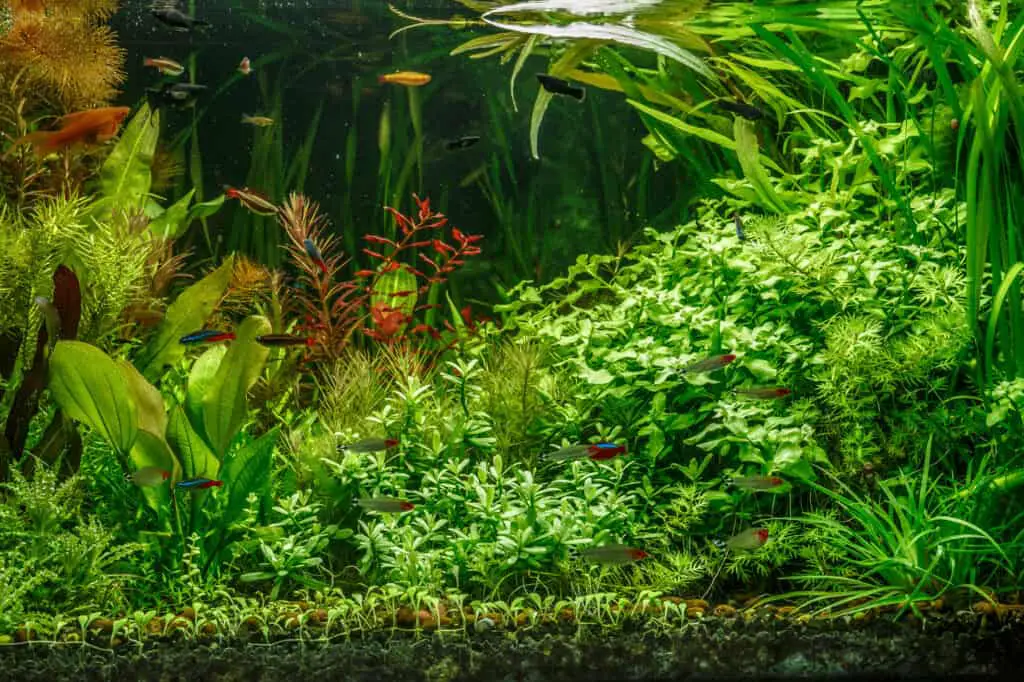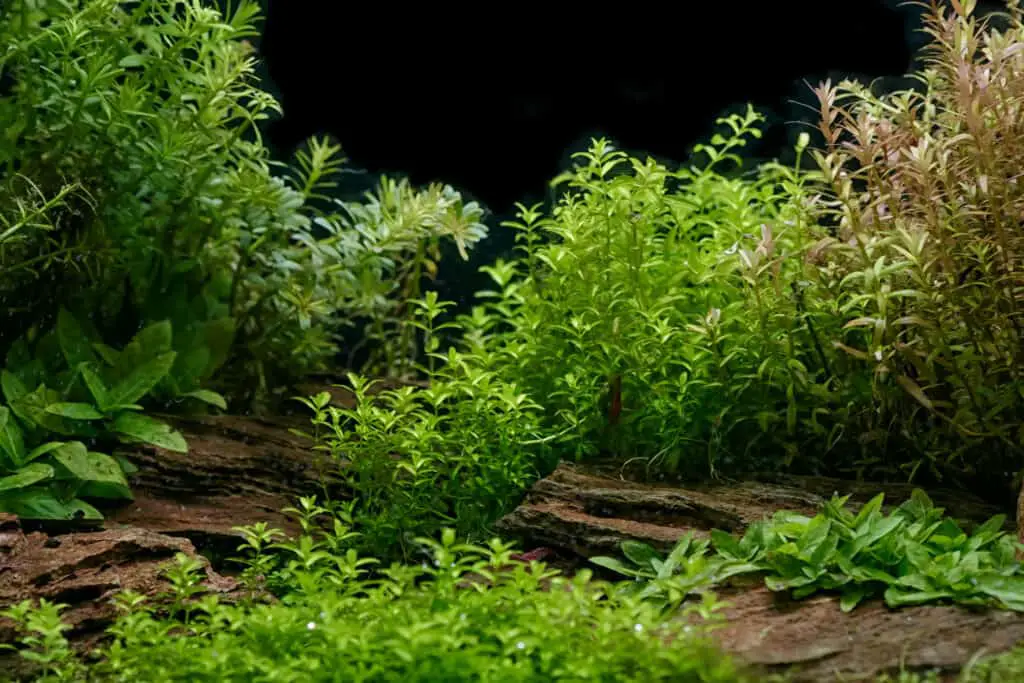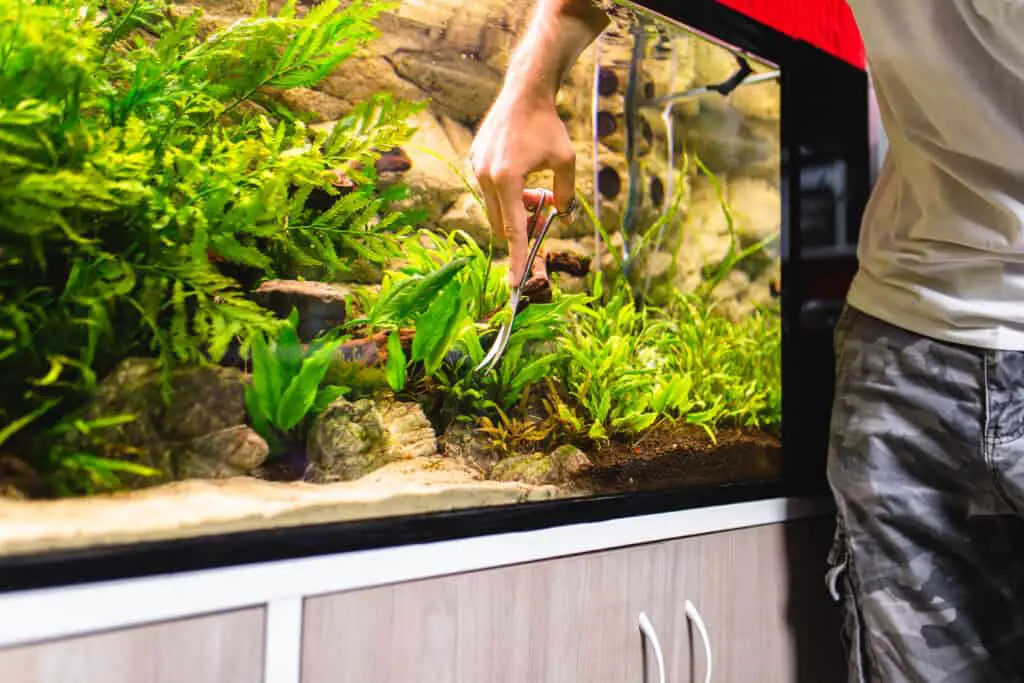
Aquariums are not just a tank filled with water, but a living ecosystem.
An important aspect of that ecosystem can be live plants, and the benefits of these plants are numerous.
These benefits include oxygenated water and giving places for fish to interact and feel safe.
However, with any ecosystem, it is important to find the correct balance with everything to create a harmonious situation.
With all their benefits, there is a point where you can have too many plants—having too many plants, especially when extremely dense foliage can lead to impeded water circulation, which leads to dead spots where detritus can accumulate.
There are also risks of blocking light from reaching the entire aquarium and limiting swimming space for aquatic life.
Let’s dive deeper into the world of balancing plant life in your tank’s ecosystem, the effects of overplanting, and how to watch out for it.

Balancing Plant Life with Aquarium Size and Inhabitants
An important aspect of a planted tank is balancing the number of plants with your size tank and the number of inhabitants inside.
A larger tank will require more plants compared to a smaller tank, and a more stocked tank will come to a balancing point sooner than a less stocked tank of similar size.
Though there are many benefits to a lot of plants, they do take up space in a tank.
This space reduces the amount of swimming room for fish and other inhabitants, which at a point will become more of a hindrance to the overall happiness of the inhabitants compared to the great benefits the plants can provide.
Be sure to research the plants that you want to use in your tank, making sure to know if they are background plants (typically plants that grow taller and at a faster rate), and foreground plants (typically plants that grow at a shorter, slower rate).
Using a variation of these two types of plants can gain both the added benefit of more plants while reducing the amount of space being impeding, as it will provide ample space at the front of the tank while giving the full plant visual in the back.
Also, remember to take into account how dense the plants being chosen will get.
Plants that grow thicker leaves, and get very compact when together will limit how much and how well fish and other creatures can swim through them. Whereas plants with thinner leaves give more movability to get through them while still giving a full plant look.
Signs of Overplanting in an Aquarium
So how do you know if your aquarium is overplanted? There are a couple of visual cues to look for:
Stagnant Water Areas
One issue of overplanting, especially when using plants that are background or surface plants is a reduction in water circulation.
This will visually be seen as spots on the tank’s water surface being stagnant.
This can lead to poorer filtration in your tank, increased algae growth, and the accumulation of detritus in those areas.
Another dangerous component of stagnant areas is reducing the overall oxygen levels in the tank, as surface agitation is a major component in the process of dissolving and diffusing oxygen into your tank’s water.
If these areas are noticed in your planted tank, consider trimming those plants.
If they are surface plants like lily pads or duckweed, consider removing the portion that is on the surface to increase circulation.
Dark Spots in the Aquarium
Lack of lighting in different areas of your tank can be another sign of overplanting.
This is especially true when dealing with surface-dwelling plants since they can cover a much larger area of the surface.
The biggest disadvantage of this is for your other plants, as this will reduce the overall amount of light reaching your shorter plants, and those that are planted under the dark spots.
This increased lack of light can impact the growth and health of your plants.
Color Changes and Damage to Plants
Another issue that can be caused by overplanting is deficiencies in needed nutrients.
This is due to the amount of plants compared to the natural and supplemental nutrients, such as fertilizers and root tabs, found in the water.
The more plants that are put in the tank, the more nutrients are needed for all of the plants to continually thrive.
At some point, if overplanting has occurred, some of the plants will begin to suffer from the lack of nutrients available to them.
Two common visual ways that can alert you to deficiencies are the color of the plants changing and visible damage to the plant.
Typically with a lack of nutrients, plants will begin to yellow, and in some cases brown.
Damaged leaves such as visible holes in the leaves, and crippled or stunted growth in new leaves are another way to visibly see possible lack of nutrients from overplanting.

Maintaining Your Aquarium Plants
Live aquarium plants will of course naturally grow, so even though initially when planting there was a good balance in the amount of times, eventually there can become a time where the plants will grow into too much for the tank.
This is why maintaining and managing your aquarium plants is vital to having healthy, thriving plants, and a well-balanced tank ecosystem.
Maintaining your plants includes periodical pruning of the plants to prevent excessive growth, which in turn will ensure that they don’t overshadow smaller, and lower-level plants.
Regular checks of water parameters are also important, as well as, effective nutrient management by using correct amounts of fertilizers when necessary, controlling feeding to proper amounts, and making sure there is adequate filtration.
All of this maintenance helps both the plants and inhabitants in the tank live together harmoniously.
Final Thoughts
The adage that more plants are always better in a tank can be true in many cases, but there comes a point where the amount of plants exceeds the balance point for a tank.
Assessing your tank regularly, and looking for visual cues of possible signs of overplanting is key.
With the right balance, your tank can thrive and provide a healthy and beautiful environment for the inhabitants and yourself.
